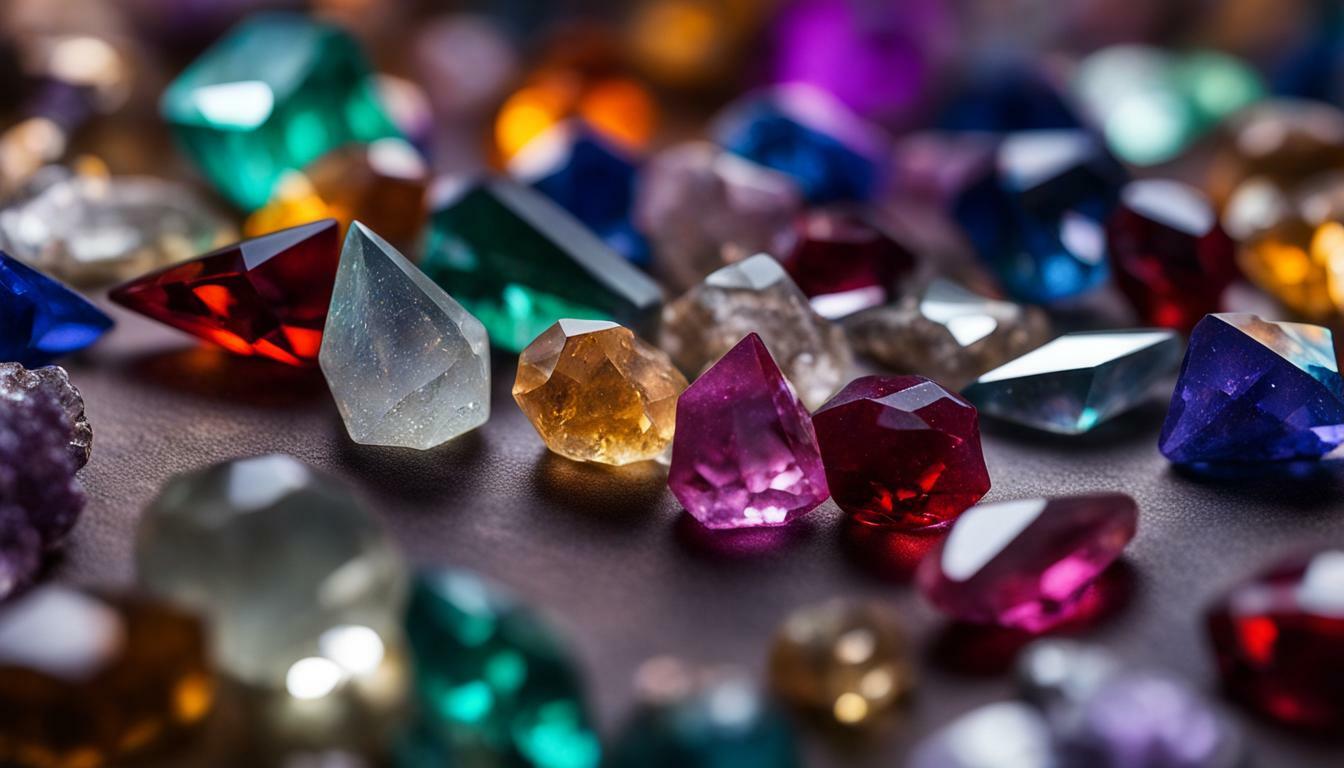Are you uncertain about the crystals you have and want to know how to identify them accurately? Crystal identification is an essential skill for any crystal enthusiast. Knowing the types of crystals you have can help you understand their unique properties and harness their energy for various purposes. In this section, we will explore different methods and techniques for crystal identification, including color, shape, and the use of identification books and apps. By the end of this section, you’ll have the tools and knowledge to confidently identify the crystals in your collection.
Key Takeaways:
- Crystal identification is important for understanding the properties and energy of the crystals you have.
- Color and shape are two key factors in identifying crystals.
- Crystal identification books and apps can be valuable resources.
- Common crystals have unique identification characteristics.
- Seeking expert help is an option for challenging crystal identifications.
Crystal Identification by Color
One of the easiest ways to identify a crystal is by examining its color and understanding the symbolism and meanings associated with different colors. Colors play a significant role in the world of crystals, as they are often linked to specific healing properties and energetic vibrations.
Here is a list of common crystal colors and their corresponding meanings:
| Color | Meaning |
|---|---|
| Black | Power, protection, grounding |
| Blue | Peace, calming, communication |
| Brown | Earthiness, stability, grounding |
| Yellow and Gold | Optimism, abundance, manifestation |
| Green | Healing, growth, harmony |
| Orange | Creativity, enthusiasm, motivation |
| Pink | Love, compassion, emotional healing |
| Grey | Balance, neutrality, protection |
| Purple | Spirituality, intuition, transformation |
| Red | Passion, vitality, courage |
| White | Purity, clarity, spiritual connection |
Keep in mind that some crystals may come in different colors, so it’s important to refer to a crystal book or directory that categorizes crystals by color and includes photos for better identification. By understanding the symbolism and meanings associated with different colors, you can gain insights into the energetic properties of the crystals you encounter.
While color is a helpful indicator, it’s important to note that other factors such as crystal shape and properties also contribute to proper identification. In the next sections, we will explore these additional methods for crystal identification.
The Shape of Crystals and Their Identification Characteristics
The shape of a crystal can reveal important information about its identity, as different crystal types have distinct shapes based on their lattice structures. By examining the shape of a crystal, you can gather valuable clues to help identify it. Here are some common crystal shapes and their corresponding lattice structures:
Cubic Crystals
Cubic crystals, such as Pyrite, Diamonds, and Fluorite, have a cubic shape formed by three equal axes. These crystals have a balanced structure, creating a peaceful and harmonious energy.
Hexagonal Crystals
Hexagonal crystals like Emerald and Aquamarine have a shape with four axes of six-sided symmetry. By identifying the hexagonal shape, you can narrow down the type of crystal you have.
Orthorhombic Crystals
Orthorhombic crystals, including Peridot and Topaz, have three unequal axes that form an elongated spear shape. These crystals are not symmetrical and can be identified by their unique shape.
Tetragonal Crystals
Tetragonal crystals, such as Apophyllite and Zircon, have a symmetrical shape that resembles two four-sided pyramids connected at the base. The various colors of these crystals add to their unique identification characteristics.
Triclinic Crystals
Triclinic crystals like Labradorite and Turquoise have an asymmetrical elongated oval shape. If your crystal has a symmetrical shape, it is unlikely to be triclinic, allowing you to identify it as a different crystal type.
By recognizing the distinctive shapes of crystals, you can begin to narrow down the possibilities of their identity. However, it is essential to consider other factors such as color, hardness, and other physical properties to confirm the identification of a crystal. It is recommended to utilize crystal identification resources such as books, directories, and mobile apps to help you in the identification process.
If you have a crystal identification book or access to a crystal identification directory, you can easily compare the characteristics of your crystals to find their specific variety. These resources provide valuable information on the physical properties, colors, and shapes of various crystals, making it easier to identify and categorize your own collection. Crystal identification books and directories are categorized by color, shape, and other characteristics, allowing you to match your crystals to the correct variety. They often include high-quality photographs or illustrations to help you visualize and compare your own specimens. Some popular crystal identification books include “The Crystal Bible” by J. Hall and “The Crystal Guide: Identification, Purpose and Values” by Patti Polk. When using a crystal identification book, start by examining the color of your crystal. Look for the main color and try to use common colors like red or blue to describe it. Compare the color of your crystal to the pictures and descriptions in the book to find a match. If you don’t have a crystal identification book, you can also search online for a crystal identification directory. For example, if you have a green stone, you can compare it to the popular green crystals like sapphire, emerald, or green fluorite. If your crystal doesn’t resemble any of these, you can explore other green crystals to find a possible match. In addition to color, you can also identify crystals by their shape. Some crystals have distinct shapes that can help narrow down their identity. For example, hexagonal-shaped crystals like emerald and aquamarine are easily recognizable. Cubic-shaped crystals like pyrite, diamonds, and fluorite are another common shape in the mineral kingdom. By observing the shape of your crystal and comparing it to the pictures in a crystal identification book or directory, you can further confirm its identity. Crystal identification apps are also a convenient tool for identifying crystals on the go. These mobile apps usually have an extensive database of crystals with photos and descriptions. They often include search functionalities based on color, shape, and other criteria. Some popular crystal identification apps include Geology Toolkit, Geology Toolkit Premium, Minerals Guide, Crystalyze, and The Magic of Crystal. These apps provide a user-friendly interface and make it easy to search and explore a wide range of crystals. While crystal identification books and apps are great resources, it’s important to note that they are not foolproof. The identification process can sometimes be challenging, especially for crystals with similar colors or shapes. In these cases, it’s always helpful to seek expert assistance from crystal identification professionals or consult community forums and groups where experienced crystal enthusiasts can offer their insights. In conclusion, crystal identification books, directories, and apps are valuable resources that can help you identify and categorize your crystals based on their color, shape, and other characteristics. By comparing the properties of your crystals to the information provided in these resources, you can gain a deeper understanding of your collection and appreciate the unique beauty and energy of each crystal.Crystal Identification Apps
In this digital age, crystal identification apps have become popular tools for easily identifying and learning about the crystals you have. These apps provide a convenient way to access a wealth of information about different crystal varieties and their unique characteristics. Here are a few crystal identification apps that can aid you on your crystal identification journey:
Stone Crystal Identification App
The Stone app is a user-friendly tool that provides crystal knowledge and information about metaphysical properties. It features a crystal gallery with images of various crystals to help you familiarize yourself with their physical appearance. While the crystal identification data in this app is limited to 69 crystals, the clean and minimalist layout makes it easy to navigate and practice picture-based identification.
Geology Toolkit
The Geology Toolkit app is a comprehensive tool for identifying minerals, rocks, and crystals. It allows users to analyze and observe mineral characteristics under hand-specimen attributes or through a microscope. The app also includes a series of questions and prompts based on color, streak, luster, hardness, and more to guide you towards the correct identification. It is a valuable resource for students and geologists.
Minerals Guide: Rocks, Crystals, and Gemstones
The Minerals Guide app offers a vast database of rocks, crystals, and gemstones for identification purposes. It allows you to search for specific characteristics like color, streak, luster, hardness, specific gravity, and more. With over 4,000 distinct crystals and their properties, this app provides a wealth of information to aid in your crystal identification journey.
Crystalyze: Crystals & Stone
The Crystalyze app features a clean and user-friendly interface, making it enjoyable to explore and learn about crystals. It provides high-resolution images of various crystals, along with their names and descriptions right on the front page. While the crystal list is limited, this app is a great tool for beginners looking to identify crystals based on their visual appearance.
The Magic of Crystal
The Magic of Crystal app offers a minimalist design and simple interface for crystal identification. It provides names, descriptions, and even information about chakras for each crystal. The app’s high-quality images and detailed descriptions make it a valuable resource for identifying crystals and understanding their energetic properties.
Geology of Rocks – Handbook of Rocks
The Geology of Rocks app is a comprehensive guide for students, geologists, and crystal enthusiasts. It offers a wide range of rocks, minerals, and crystals for identification purposes. The app allows you to provide findings and observations in exchange for high-quality results and detailed information. It is a valuable tool for expanding your knowledge and deepening your understanding of crystals.
These crystal identification apps can be a helpful companion on your crystal identification journey. Whether you’re a beginner or an experienced crystal enthusiast, these apps provide easy access to information and resources that can aid in the identification and understanding of the crystals you have.
Common Crystals and Their Identification Characteristics
Here are some examples of common crystals and the characteristics you can look for to identify them accurately:
Amethyst
Color: Purple
Identification Characteristics: Amethyst is a type of quartz known for its deep purple color. It often has a transparent to translucent appearance and can display variations in shade, ranging from light lavender to dark purple. Amethyst crystals typically have a six-sided prism shape with pointed terminations.
Clear Quartz
Color: Clear or white
Identification Characteristics: Clear quartz is a versatile and abundant crystal that can be found in various forms, such as clusters, points, or tumbled stones. It is known for its clear and transparent appearance, although it may contain inclusions or veils. Clear quartz crystals often have a hexagonal shape with pointed terminations.
Rose Quartz
Color: Pink
Identification Characteristics: Rose quartz is a variety of quartz that ranges in color from pale pink to a deeper rose shade. It has a translucent to transparent appearance and may contain natural internal fractures or inclusions. Rose quartz crystals often have a hexagonal shape with pointed terminations, similar to other quartz varieties.
Citrine
Color: Yellow to golden brown
Identification Characteristics: Citrine is a yellow to golden brown variety of quartz. It can range in color intensity from pale yellow to a deep golden hue. Citrine crystals may have a transparent to translucent appearance and often have a hexagonal shape with pointed terminations. Natural citrine is less common than heat-treated amethyst, which turns into citrine when exposed to high temperatures.
Labradorite
Color: Gray with iridescent flashes
Identification Characteristics: Labradorite is a feldspar mineral known for its iridescent play of colors, often referred to as labradorescence. It has a gray or gray-green base color and displays flashes of blue, green, gold, and other hues when viewed from different angles. Labradorite crystals may have a triclinic shape, which is asymmetrical and elongated.
Blue Lace Agate
Color: Pale blue with white banding
Identification Characteristics: Blue lace agate is a variety of chalcedony with a beautiful pale blue color and white banding. It has a translucent to opaque appearance and often occurs in banded formations. Blue lace agate crystals may be tumbled or cut into cabochons for jewelry purposes.
Carnelian
Color: Orange to reddish-brown
Identification Characteristics: Carnelian is a form of chalcedony that ranges in color from orange to reddish-brown. It has a translucent to opaque appearance and often exhibits a smooth and polished surface. Carnelian crystals may be tumbled or carved into various shapes and are prized for their vibrant color.
Black Tourmaline
Color: Black
Identification Characteristics: Black tourmaline is a powerful protective crystal known for its black color. It has a shiny or glassy appearance and may exhibit striations or parallel lines on its surface. Black tourmaline crystals often have a prismatic shape with striated sides.
“Crystals have evolved over millions and millions of years, thanks to chemical reactions between minerals within earth’s molten core.”
These are just a few examples of common crystals and their identification characteristics. Each crystal has its own unique properties and visual cues that can aid in identification. By familiarizing yourself with these characteristics and using crystal identification resources like books or apps, you can confidently identify the crystals in your collection and deepen your understanding of their energetic properties.
Tips for Crystal Identification
If you’re new to crystal identification, these tips and techniques can help you navigate the process with greater ease and accuracy.
1. Examine Color and Consult a Crystal Identification Book
One of the easiest ways to identify a crystal is by looking at its color. Common colors like red, blue, green, and purple can provide clues about the type of crystal you have. Use a crystal identification book that categorizes crystals by color to match your stone to the correct variety. If you don’t have a crystal identification book, you can search online for a crystal identification directory.
2. Compare Shapes and Reference Crystal Charts
The shape of a crystal can also provide valuable clues for identification. Different crystal shapes, such as cubic, hexagonal, orthorhombic, and tetragonal, correspond to specific crystal lattice structures. By comparing the shape of your crystal to crystal charts or guides, you can narrow down the possibilities and identify your crystal more accurately.
3. Utilize Crystal Identification Apps
In today’s digital age, there are several crystal identification apps available for smartphones. These apps use image recognition technology to match your crystal to a database of known crystals. Simply take a photo of your crystal and let the app do the rest. Popular crystal identification apps include Stone, Geology Toolkit, and Minerals Guide. These apps are a convenient tool for identifying crystals on the go.
4. Seek Expert Help and Consult Crystal Identification Experts
If you’re still having trouble identifying your crystal, don’t hesitate to seek expert help. Crystal identification experts and professionals have extensive knowledge and experience in identifying crystals. They can provide valuable insights and guidance in the identification process. Local crystal shops or gemologists can be a great resource for finding experts in your area.
5. Understand Crystal Identification Characteristics
Each crystal has unique identification characteristics that can help narrow down its identity. Familiarize yourself with common crystal identification characteristics such as color, streak, luster, hardness, specific gravity, and crystal structure. Having a good understanding of these characteristics will make the identification process more successful.
6. Make Use of Crystal Identification Resources
There are many resources available that can assist in crystal identification. Crystal identification books, such as “The Crystal Bible” by J. Hall and “The Crystal Guide: Identification, Purpose and Values” by Patti Polk, are widely used references. Online crystal identification directories and websites dedicated to crystal identification can also provide valuable information.
“Crystals have evolved over millions and millions of years thanks to chemical reactions between minerals within earth’s molten core.”
“Colors are another common crystal identification method. In fact, many gemstone experts classify crystals according to color because of its link with specific healing properties.”
By following these tips and utilizing the available resources, you can enhance your crystal identification skills and confidently identify the crystals in your collection. Remember, practice and observation are key in becoming proficient in crystal identification. Enjoy the journey of discovering the unique beauty and energy of each crystal!
Seeking Expert Help for Crystal Identification
If you’re still uncertain about the identification of a particular crystal, reaching out to crystal identification experts can provide valuable assistance. These professionals have in-depth knowledge and experience in the field of crystals, allowing them to accurately identify and classify a wide range of specimens.
Crystal identification experts can analyze various factors such as the crystal’s physical properties, chemical composition, and unique characteristics to determine its exact identity. They often utilize specialized tools and techniques to conduct thorough examinations and comparisons.
When seeking expert help for crystal identification, it is important to find reputable and knowledgeable professionals. Here are a few options to consider:
- Contact local crystal shops or gemstone stores that have knowledgeable staff. These individuals are often experienced in working with crystals and can provide valuable insights and guidance.
- Join crystal identification forums or online communities where experts and enthusiasts gather to discuss and share their expertise. These platforms allow you to post clear pictures and descriptions of your crystal, and receive input from knowledgeable individuals.
- Attend crystal identification workshops or events hosted by reputable organizations or experts. These educational opportunities provide hands-on experience and the chance to learn from experienced crystal identification professionals.
- Consult crystal identification books and resources authored by reputable experts. These resources often provide detailed information on various crystals and their identification characteristics.
Remember, crystal identification is a complex process that requires expertise and knowledge. It is always recommended to seek assistance from professionals who have the necessary experience and understanding of crystals. They can help you identify your crystal accurately and provide additional insights into its properties, uses, and energetic qualities.
Conclusion
Identifying the crystals you have can be an exciting and enlightening process, and with the right tools and knowledge, you can confidently recognize and appreciate the unique beauty and energy of each crystal. By exploring methods such as crystal identification by color and shape, utilizing crystal identification books or directories, and using crystal identification apps, you can enhance your understanding of the crystals in your collection. Additionally, familiarizing yourself with the characteristics of common crystals and implementing practical identification tips can further support your crystal identification journey. Remember, if you encounter challenges or need expert assistance, seeking help from crystal identification professionals can provide valuable guidance. This article has provided you with the necessary information to embark on your crystal identification adventure and deepen your connection to the mineral kingdom.
What are the Methods to Identify the Crystals I Possess?
Identifying the crystals in your possession is crucial for any crystal enthusiast. Understanding the properties and energies of each crystal in your collection allows you to harness their benefits more effectively. Various methods can aid in knowing your crystal collection. Conducting research, consulting crystal identification books or websites, seeking guidance from experienced crystal practitioners, and using crystal testing tools such as color charts, hardness tests, or crystal lattice examinations can all provide valuable insights into the identity of your crystals.
FAQ
Q: How can I identify crystals by their color?
A: Colors can be a helpful clue in identifying crystals. Different colors are often associated with specific types of crystals. Using a crystal identification book or directory that categorizes crystals by color can help match your crystal to the correct variety.
Q: How can I identify crystals by their shape?
A: The shape of a crystal can provide clues to its identity. Crystals have different shapes based on their lattice structures. For example, cubic crystals like pyrite, diamonds, and fluorite have a square pattern, while hexagonal crystals like emerald and aquamarine have a six-sided symmetry.
Q: Are there any apps available for crystal identification?
A: Yes, there are crystal identification apps that can help you identify crystals on the go. Some popular apps include Stone Crystal Identification, Geology Toolkit, and Crystalyze. These apps provide information and images of various crystals to aid in their identification.
Q: What are some common crystals and their identification characteristics?
A: Some common crystals and their identification characteristics include amethyst and charoite for purple crystals, rose quartz and rhodochrosite for pink crystals, golden topaz and citrine for yellow or gold crystals, and garnet and ruby for red crystals. Each crystal has its own unique properties that can help in identification.
Q: What should I do if I’m having trouble identifying a crystal?
A: If you’re having trouble identifying a crystal, you can seek help from crystal identification experts or professionals. They have knowledge and experience in identifying crystals and can provide assistance in determining the type of crystal you have.
Q: What is the importance of crystal identification?
A: Crystal identification is important for understanding the unique properties and characteristics of different crystals. It can help you harness the specific energies and benefits of each crystal, as well as ensure that you are using the correct crystal for your intended purpose.








